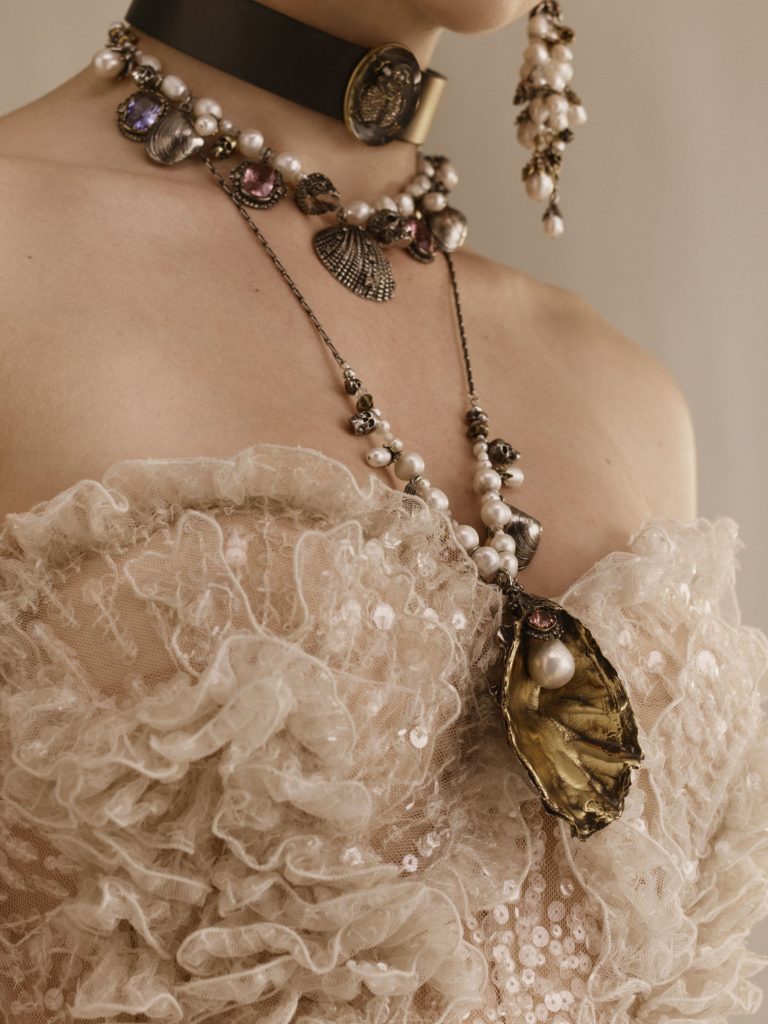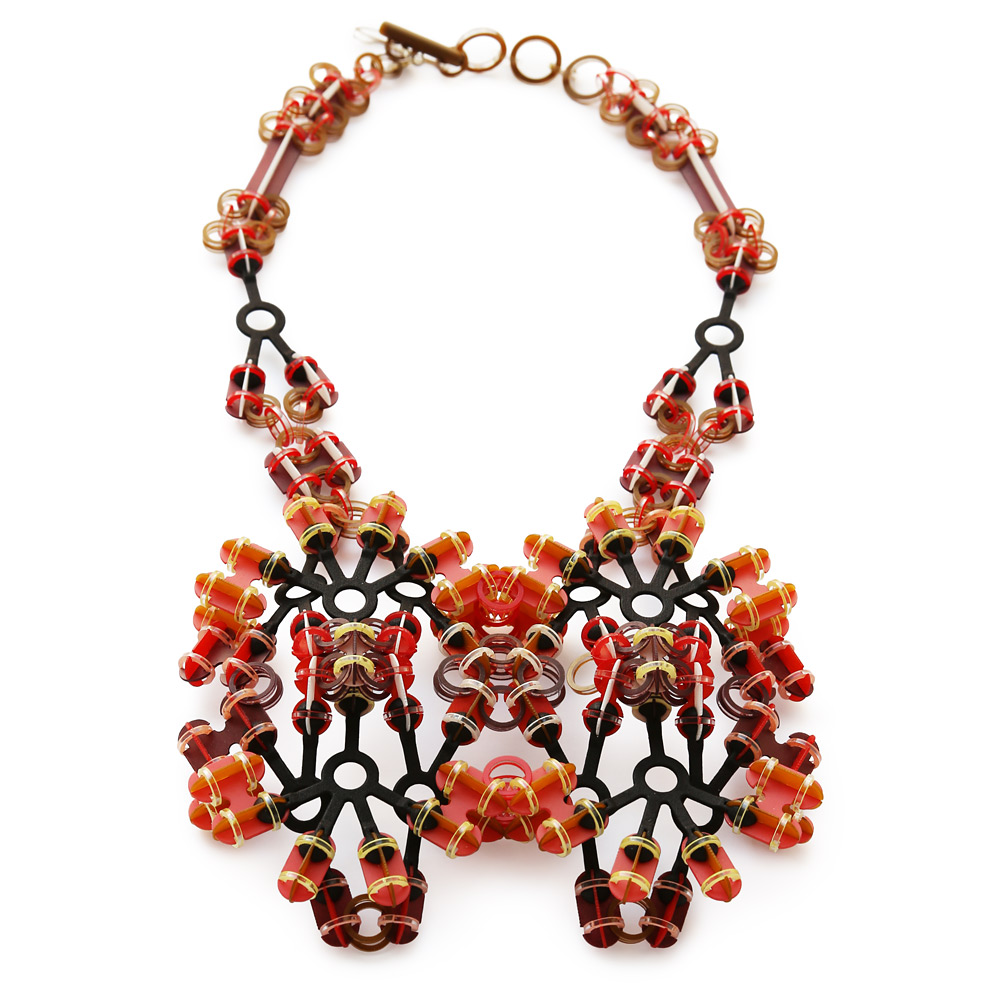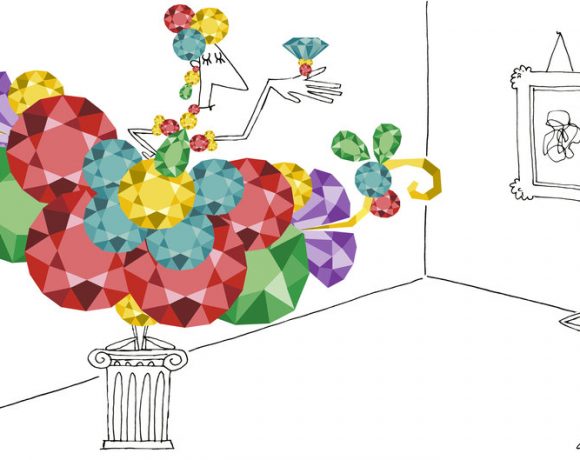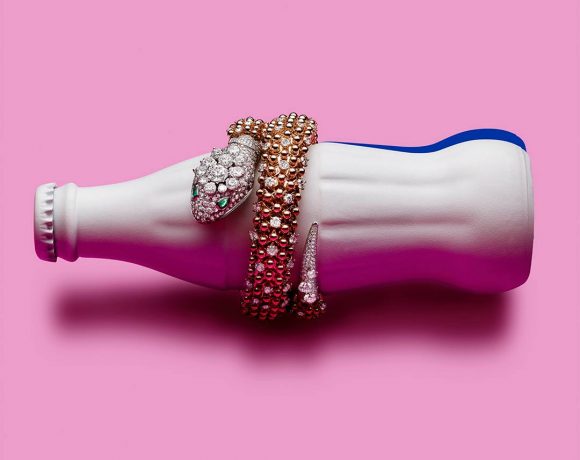If you’ve ever watched a runway show and thought, “What in the heck are those people wearing?” The answer is likely wearable art. It can be made from any material, natural or manmade, from glittering gold to recycled plastic. Wearable art, aka artwear, is unique, individually designed, and crafted by hand. The movement got its start in the 60s and has gathered steam over the decades. With the increasing emphasis on personal expression, artwear is more popular than ever today. Read on to learn more about the artsy side of jewelry.
Inspired by the Wildest Dreams

Image: Alexander McQueen Spring/Summer 2019 pre-collection, alexandermcqueen.com
The late Alexander McQueen is the man whom many consider being the father of wearable art. Always pushing the limits, McQueen once had an amputee model walk the runway in a pair of hand-carved wooden legs. While his collections also included more practical items such as pencil skirts, his wearable art is like something out of a fantasy. Inspired by nature as well as his wildest dreams, McQueen incorporated a vast array of materials from clamshells to animal tusks into his one-of-a-kind pieces that were and still are at the forefront of fashion.
Fleeting Inspiration
One of the hottest wearable jewelry artists today is Kazumi Nagano. Nagano got her start with a chance encounter at the studio of Minato Nakamura. Nagano knew nothing about contemporary jewelry, but it spoke to her soul and she dove in headfirst. Her other inspirations include Kayama Matazo’s work and Japanese-style painting. The latter seeks to portray the beauty and transience of nature as it changes through the seasons. Nagano using a variety of materials to create her ethereal pieces, including gold, silver, linen thread, and bamboo fiber. Her wearable art can be found in many galleries and museums around the world, including the Victoria and Albert Museum in London.
Also inspired by traditional art is the Akola collective. ‘Akola’ means ‘she works’ in a local dialect of Uganda. Built from the ground up, Akola employs women across Uganda with the goal of empowering women and advancing economic development throughout the continent of Africa. The affordably priced pieces are handcrafted by artisans using a variety of materials including metal, glass, raffia, and bone, and reflect traditional art as well as contemporary designs. Akola also provides access to educational programs to its all-female workforce on topics such as finance and leadership.
While some wearable artists are classically trained, many are self-taught, including Montana-based bead artist Laura Lee Ullrich. She got her start by picking out a project from a magazine and was immediately hooked. Along the way, Ullrich has connected with others in her field who helped her learn a few tricks of the trade. Ullrich’s designs are the ultimate in handcrafting: she sews on each bead one at a time. Ullrich finds inspiration in nature. She sometimes incorporates an antique into her pieces and believes doing so adds soul. Ullrich also says that being creative is integral to her happiness, and she strives to work on her art every single day.
Intensity and Enchantment

Image: Mirjam Hiller jewelry, mirjamhiller.com
For some, creating art is about having no limits. For others, imposing rules is all part of the challenge. German wearable jewelry artist Mirjam Hiller uses single materials, such as a single sheet of metal, to create her pieces. She looks for the beauty in the banal and the bizarre and wants her art to engage the senses and take viewers into another world. She believes art should awaken curiosity in the individual, as well as make them want to own and wear it.

Image: Barbara Ebbli jewelry, malaika.biz
Found objects are another popular material used by wearable jewelry artists. Born in Africa, raised in Indonesia, educated in America, and now residing in Italy, Barbara Ebbli is a true citizen of the world and creates pieces that reflects her background. She incorporates rules with nature to create one-of-a-kind wearable art from shells she finds on the beach along the Adriatic coast. The gold or silver setting is hand-shaped to conform to the contours of the shell without using any type of adhesive. Her principle is: The shell rules and the craftsperson must follow. The result is something that looks simple but is powerful, timeless and relatable no matter who you are or where you come from.

Svenja John jewelry, oona-galerie.de
Cutting-Edge Vision
One of the delights of wearable art is that it can be created from literally anything: precious stones, found objects, and even high-tech materials like polycarbonate film. One artist who is using not only modern materials but also cutting-edge technology is Berlin-based Svenja John. Her attitude toward creating art is why use medieval techniques when we live in a modern world? John’s latest love is a material called Makrofol foil, a tough, heat-resistant yet elastic material also used in automotive equipment. It can be cut like metal and offers endless possibilities as to finish, from matte to sparkling, to create exactly the effect she is looking for. John sketches and makes paper models, then switches over to CAD to create her unique geometric shapes. Next, she uses waterjet technology to make the precision cuts. The finishing, coloring, and final assembly are all done by hand. John is excited about the prospect of pushing her jewelry engineering skills into the not-yet-invented technologies of the future.
Future Heirlooms
Wearable art is often considered to be the antithesis of fast fashion. Thoughtful, distinctive yet eternal compositions created with the intention to last a lifetime and beyond, many wearable jewelry artisans design with the future in mind. Sisters Morgan and Jaclyn Solomon combined their commitment to sustainability with their passion for architectural design to found AGMES. Based in New York, they hand-create each piece using gold, silver, and freshwater pearls. Any scrap metal is melted down for reuse. Their zero-waste approach includes working exclusively with local businesses in creating prototypes through production to packaging. AGMES donates a percentage of their sales to charitable causes.
Every human has creative potential. The trick is finding the right medium. If you’re thinking you’d like to try creating some wearable art but haven’t even picked up a colored pencil since grade school, take heart. Making art doesn’t have to be complicated. Many artists work with simple tools you can find right in your average toolbox, sewing kit, or even a kitchen drawer. A studio need not be a huge separate space. It can be as modest as a small table in a spare room. Many artists say that the process of creating teaches them a lot about themselves. Whether your idea of art involves precious materials or simply stringing beads on thread, anyone can tap their imagination and become a creator of wearable art.
Author’s bio: Sue Seabury is a content writer at Laguna Pearl. She is passionate about fashion, travel and people, and loves sharing the hottest style trends with the world.









NO COMMENT